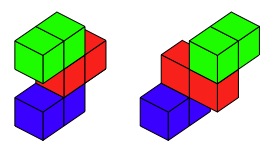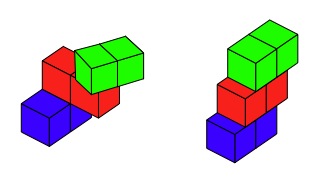Or search by topic
Number and algebra
Geometry and measure
Probability and statistics
Working mathematically
Advanced mathematics
For younger learners
Building with Rods



- Problem
- Student Solutions
- Teachers' Resources
Building with Rods
We have three rods that are each 2 units long.
The different colours are used to make the diagrams clearer and they always remain in the same place i.e the blue as the bottom layer, the green as the top layer and the red as the middle layer.
The challenge is to find how many different ways you can stack these rods.
The rule is that one or both of the small cubes must sit squarely on top of other small cubes.
It does not matter if they are likely to topple over.
Both these two arrangements fit the rule.

However, these two arrangements do not fit the rule as the rods have to be lined up squarely and each little cube must sit on top of one other cube and not overlap two cubes.

How can you convince someone that you have found all the possibilities?
Why do this problem?
Possible approach
Key questions
Can you describe the ways that you arrived at these shape arrangements?
How did you construct these on the computer?
Possible extension
Possible support
Teacher Support
This task was created to help in the pursuance of curiosity within the Mathematics lessons.Help may be found in the realm of curiosity in watching parts of these excellent videos.
Firstly "The Rise & Fall of Curiosity", particularly the extract [23.50 - 37.15] on "adult encouragement answering and teacher behaviour."
Secondly, "The Hungry Mind: The Origins of Curiosity", particularly the extract [8.22 - 12.29] on "Children asking questions"
First can also be found at - https://www.youtube.com/watch?v=X-0NOrIU67w
Second can also be found at https://www.youtube.com/watch?v=Wh4WAdw-oq8
You may also like
Geoboards
This practical challenge invites you to investigate the different squares you can make on a square geoboard or pegboard.

